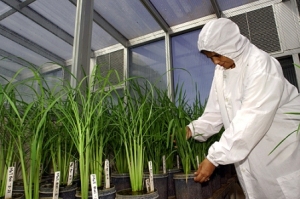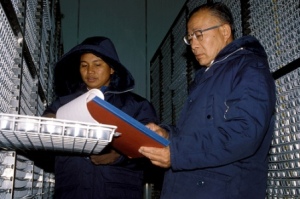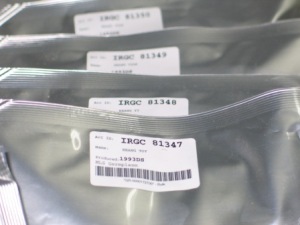CGKB News and events Rice
Transgenes in cultivated rice, wild rice and related genera genetic resources
Contributors to this page: T.T. Chang Genetic Resources Centre-IRRI, Los Baños, Philippines (Ruaraidh Sackville Hamilton, Ken McNally, Flora de Guzman, Renato Reaño, Soccie Almazan, Adelaida Alcantara, Elizabeth Naredo); WARDA, Cotonou, Benin (Ines Sánchez); UPLB-University of the Philippines at Los Baños (Teresita Borromeo).
Transgene detection in seed banks is important for those crops that have undergone transgenic events and where transgenic varieties have been used in the area of collection. However, transgenic rice has been detected adventitiously in many countries that officially have no transgenic rice. Click here for more information about IRRI policies.
 Inspecting Vitamin A rice plants being grown inside a CL4 facility at IRRI (photo: IRRI) |
List of current transgenes
Transgenic rice is not yet officially released anywhere. However, transgenic rice is being developed and unintentional releases have occurred, namely:
- Bt (insect resistance) in China.
- Liberty Link (herbicide tolerance) adventitious occurrence reported in many countries.
- Golden Rice (nutritionally enhanced with provitamin A) being tested in many Asian countries (click here for more detailed information).
Determination methods
- Test all incoming samples coming from high risk countries. Use PCR or herbicide leaf painting assay for material coming from USA Bayer Liberty link.
- Or do not accept samples coming from high risk countries of possible illegal release of GMO.
- Hybridization can occur naturally between cultivated and some species of wild rice. Therefore the same determination methods should be applied to incoming samples of these wild species.
Recording information during transgenes determination
The following information should be recorded for each step:
- See specific details about transgenes on this site.
References and further reading
Golden rice project [homepage] [online]. 2009. Available from: http://www.goldenrice.org. Date accessed: 10 July 2013.
Lemaux GP. LL601 Rice. What Is It & What Does It Mean? Available from: http://ucbiotech.org/resources/factsheets/LibertyLink.pdf. Date accessed: 10 July 2013.
IRRI. 1997. Bt rice: Research and policy issues. IRRI Information Series No. 5. International Rice Research Institute, Philippines. ISSN 0117-3715. Available from: http://www.irri.org/publications/pdfs/bt.pdf. Date accessed: 10 July 2013.
Wang Y, Jonhston S. 2007. The status of GM rice R&D in China. Nature Biotechnology. 25:717-718. Abstract available from:
http://www.nature.com/nbt/journal/v25/n7/full/nbt0707-717.html. Date accessed: 10 July 2013.
Seed bank for cultivated rice genetic resources
Contributors to this page: T.T. Chang Genetic Resources Centre-IRRI, Los Baños, Philippines (Ruaraidh Sackville Hamilton, Ken McNally, Flora de Guzman, Renato Reaño, Soccie Almazan, Adelaida Alcantara, Elizabeth Naredo); WARDA, Cotonou, Benin (Ines Sánchez); UPLB-University of the Philippines at Los Baños (Teresita Borromeo).
When seed banks are used
 Inspecting records inside IRRI's International Rice Genebank. (photo: IRRI) |
Conservation of rice seed materials under cold (between 2 and -20oC) and dry (moisture content of 6-7% fresh weight) storage is the most common, efficient and cheap means of conservation of rice genetic resources. There are more than 480 000 samples of cultivated rice seeds conserved in seed banks worldwide. Most cultivated rice accessions are conserved in seed banks.
- Should be used for any rice accessions and species that produce seed that remain viable under the standard cold and dry seed storage conditions.
Field bank (cultivated rice)
Contributors to this page: T.T. Chang Genetic Resources Centre-IRRI, Philippines (Ruaraidh Hamilton, Ken McNally, Flora de Guzman, Renato Reaño, Soccie Almazan, Adelaida Alcantara, Elizabeth Naredo); WARDA, Cotonou (Ines Sánchez); UPLB-University of the Philippines at Los Baños (Teresita Borromeo).
Provides guidelines and recommendations about the best practices for the daily management of genebanks, describing when and how field genebanks should be used for rice. Best practices are shown in a pale blue color with bullets. Justification for each best practice is given within brackets (…).
When should be used?
Rice field banks conserves rice as live plants in the field or screenhouses.
- When cultivated rice seeds have low viability or low seed stocks.
How should be done?
- It recommended that distinct and completely independent areas are used for cultivated and wild types (to avoid the risk of mixtures with the highly invasive wild species).
- It is advisable to grow them in individual pots or special propagation beds, inside quarantine screenhouses.
- Perennial species should be maintained as living plants when seeds are difficult to produce.
Storage in field banks (cultivated rice)
Contributors to this page: T.T. Chang Genetic Resources Centre-IRRI, Philippines (Ruaraidh Hamilton, Ken McNally, Flora de Guzman, Renato Reaño, Soccie Almazan, Adelaida Alcantara, Elizabeth Naredo); WARDA, Cotonou (Ines Sánchez); UPLB-University of the Philippines at Los Baños (Teresita Borromeo).
Provides guidelines and recommendations about the best practices for the daily management of genebanks, describing the most important procedures for storage in field genebanks for cultivated rice. Best practices are shown in a pale blue color with bullets. Justification for each best practice is given within brackets (…).
Storage specifications
Moisture-proof laminated aluminium foil packaging for active storage. (photo: IRRI)
Planting

- Seeds should be germinated in flat seed boxes and transplanted to concrete beds after 21 days or when seedlings are vigorous enough and can withstand stress upon transplanting.
- The concrete beds can be small 'field-like' lowland plots constructed inside the screenhouse, about 2.5m wide and 11m long, like the ones used at IRRI.
Before transplanting
- Soil preparation can be done by a mechanical mini-hydrotiller after re-shoveling manually.
- Use 500g of complete fertilizer mixed well with the soil as basal fertilizer application before final soil leveling and lay-out.
Transplanting
- Transplant 2-3 seedlings per hill using 25cm spacing between hills and between rows, leaving one row vacant between entries in the lay-out.
- For insufficient seedlings (1-3 seedlings), transplanting should be done in pots to ensure the continuous growth of the plant.
- In these cases, additional care should be extended in plant maintenance, such that daily monitoring of plant health.
Field maintenance and management
Insecticide:
- Spray a pre-emergence herbicide and a granular insecticide applying a day after transplanting.
Fertilizer:
- Do a top dressing at 30 and 45 days after transplant with 350g and 300g of ammonium sulfate, respectively, for the indica and javanica types.
- For the japonica types, top dressing should be done earlier at 10 and 20 days after transplanting because spikelet fertility is highly affected.
Irrigation:
- Maintain the water level until panicle initiation. For the upland types, water should be withheld 30 days after transplant to provide drier soil conditions.
Pest and disease control:
- Regular monitoring of pest and disease incidence should be coordinated with the plant health experts and specific control measures applied when needed.
Harvesting materials:
- Panicle harvesting is observed for easy handling and verification.
- Harvested panicles should be dried and kept in the drying room for 2 weeks before finally hand-threshing.
Storage management
System for tracking materials/inventory system during field bank storage
- Use databases of stock and location (databases are needed to keep track of information).
- Use pegs, tags or bar codes for labeling:
- Use impermeable ink and write clearly.
- Plots must be well labeled to avoid errors.
- Bar codes help avoid errors in recording.
Recording information during field bank storage
The following information should be recorded for each step:
- Site name and map/GPS reference.
- Name of collaborator.
- Field bank site name (a code to identify the site location).
- Plot reference (the plot number at the field site).
- Accession number; population identification.
- Name of staff (name of staff recording the data).
- Method of planting, date and spacing.
- Field layout used.
- Field management details (watering, fertilizer, weeding, pest and disease control, stresses recorded, others).
- Environmental conditions (altitude, precipitation, temperature, soil type and others).
- Number of plants established.
- Days from planting to flowering (note: this will only be important if seed collection is anticipated).
- Harvest date and method.
- Number of plants harvested.
- Comparisons with reference materials (record any identification numbers or references of any samples taken from the plots).
- Any evaluation undertaken during the growing period or at harvest.
- Post harvest (describe any relevant procedures).
- Others.
More Articles...
Subcategories
-
main
- Article Count:
- 1
-
Regeneration
- Article Count:
- 3
-
Conservation
- Article Count:
- 1
-
Safety duplication
- Article Count:
- 1
-
Characterization
- Article Count:
- 3
-
Conservation - Wild Rice
- Article Count:
- 7
-
Conservation - Cultivated Rice
- Article Count:
- 13




